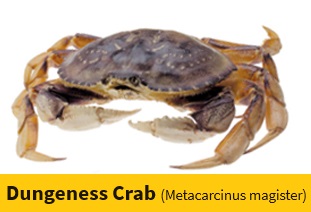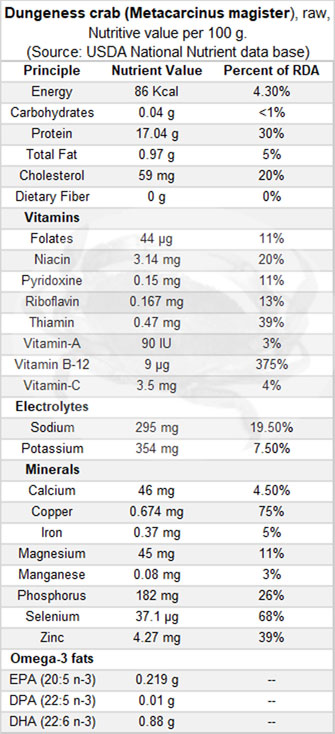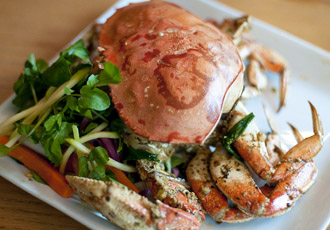Dungeness crab
Dungeness crab is a highly nutritious seafood known for its sweet, delicate flavor. It belongs to the Cancridae family, and is common and widespread in sandy areas along the British Columbia coast from the intertidal to a depth of about 180 meters (600 feet).
Scientific name: Metacarcinus magister. Other name is Market crab. It is named after the coastal town of Dungeness, in the state Washington, United States.
 |
Description
Dungeness crab is recognized for its large, oval-shaped body (hard shell) and reddish-brown coloration with white-tipped claws. It has four pairs of walking legs and a pair of claws for feeding and defense. The underside is white to light orange. A mature male Dungeness crab, meeting legal size criteria, should measure 6 ½ inches across its carapace (shoulder width) and weighs around 2 pounds.
Dungeness crab is distinguished from other crab (king and Tanner crab) by its smaller legs and the dorsal surface of its carapace is smooth and spineless.
Biology & Habitat
Dungeness crab reach maturity in about three years. Mature females generally molt between spring and fall. Males molt at variable times during the year. Mating occurs immediately after the female has molted and before the new exoskeleton hardens.
Breeding occurs in inshore waters and females may move to deeper water to hatch eggs. crabs remain in lower intertidal or shallow sub-tidal waters. Adult crabs may live to over 10 years.
Dungeness crab feed on bivalves, crustaceans, marine worms, and tiny fish. Predators include other crab species, halibut, dogfish, sculpin, octopus, rockfish, birds, and sea otters.
Fisheries
Dungeness crabs are caught commercially with pots or ring nets, and by subsistence, personal use, and sport fishermen with pots, ring nets, or snares.
Health Benefits of Dungeness crab
Dungeness crab is a delicious and low-caorie nutritious seafood option, offering several essential nutrients. 100 g (3.5 oz) servings of its claw meat contains just 86 calories and less than 1 gram of fat.
Its lean, white meat serves as an excellent source of protein, containing 17.04 g/100 g (equivalent to 30% of the Recommended Daily Intake). Carb meat protein is complete in the sense that it provides all essential amino acids in a healthy proportion for cell repair, muscle development, and overall growth in the body.
It is a good source of omega-3 fatty acids, particularly EPA (eicosapentaenoic acid) and DHA (docosahexaenoic acid). These healthy fats are crucial for heart health, brain function, and reducing inflammation in the body.
Omega-3s are known for their potential to lower the risk of heart disease, support cognitive function, and promote joint health. The American Heart Association recommends seafood due to its diverse range of nutrients, essential fatty acids, vitamins, and minerals that play vital roles in metabolic functions.
Dungeness crab meat also provides vitamins A, D, E, and B-complex vitamins like B-12, folate, niacin, pyridoxine, thiamin, and riboflavin.
100 g fresh crab meat provides 9 μg or 375% of daily-required levels of vitamin B-12. Vitamin B12 plays a crucial role in supporting red blood cell formation, neurological function, DNA synthesis, and overall cell metabolism within the body.
They contain very little but permissible levels (0.012 Parts Per Million (PPM)) of methyl-mercury, making it a safer choice, especially for pregnant women and young children. The Food and Drug Administration (FDA) recommends that pregnant women consume at least 8 to 12 ounces (about 340 grams) of seafood with low mercury content per week.
Dungeness crab s are an abundant source of essential minerals, including copper (75% of the Recommended Daily Intake), selenium (68% of the RDI), iodine, calcium, zinc (39% of the RDI), potassium, phosphorus (26% of the RDI), and magnesium.
Dungeness contains very little but permissible levels (0.065 Parts Per Million (PPM)) of methyl-mercury, making it a safer choice, especially for pregnant women and young children. The Food and Drug Administration (FDA) recommends that pregnant women consume at least 8 to 12 ounces (about 340 grams) of seafood with low mercury content per week.
 |
Buying
Buy live, fresh. They should be lively, with their shells intact, and feel heavy for their size. Dungeness crab is available whole (live, fresh-cooked or frozen), and as leg and body meat. The leg and body meat is available fresh-cooked, frozen or canned.
Storing
If you've bought live Dungeness crabs, keep them alive until you're ready to cook them. Store live crabs in a well-ventilated container or a cooler with ice packs to keep them cool and moist.
If you've already cooked the crabs and have leftovers, it is crucial to refrigerate them properly to maintain freshness.
Store the crab wrapped in a damp cloth inside the refrigerator.
Preparation- How to remove meat from crab?
Remember, handling live crabs requires caution. They have sharp claws and can pinch, so handle them carefully.
Preparing a Dungeness crab for cooking involves several steps to ensure it is cleaned and ready for your recipe.- Prepare a Boiling Pot: Fill a large pot with enough water to fully submerge the crab. Add salt to the water (approximately 1/4 cup per gallon) and bring it to a boil.
- Clean the Crab: Hold the live crab firmly and place it belly up. Remove the apron (a small tab-like structure) on the underside of the crab by pulling it upwards and away from the body. Discard this part.
- Cook the Crab: Once the water is boiling, carefully place the crab(s) into the pot. Cover and boil them for about 15-20 minutes, depending on the size. Ensure the crab is fully submerged. They're cooked when their shells turn bright orange. Then, using tongs, carefully remove the cooked crab from the boiling water and place it in a large bowl or on a tray to cool down.
- Cleaning and Breaking Down: Once the crab is cool enough to handle, you can clean it by removing the top shell (carapace) by lifting it from the back and pulling it off. Remove the grayish-green gills and discard them. Rinse the body cavity under running water to remove any remaining bits.
- Separate the Sections: Break the crab into sections by gently twisting off the legs and claws. Use a crab/lobster cracker or a mallet to crack the shells and retrieve the meat inside.
- The yield of crab meat is approximately 35%.
Here are some serving ideas:
Dungeness crab is a delicious and versatile ingredient that can be used in various recipes, from salads to soups and main dishes. The crab has a delicate flavor, so it is best to not overpower it with strong spices or ingredients.
The meat has a sweet, mild and slightly nutty taste with tender body meat and slightly firmer leg meat.
 |
| Dungeness crab-recipe. Photo: Geoffrey Smith |
Dungeness crab cakes are American favorite served with a side of tartar sauce or aioli.
Add boiled Dungeness crab meat to the mix of mayonnaise, dijon mustard, lemon juice, salt, and pepper. Chill the salad for at least 30 minutes before serving. Serve on a bed of lettuce or with crackers.
Prepare San Francisco-style Dungeness crab cioppino and serve the cioppino in bowls, garnished with chopped parsley.
Serve the garlic butter roasted Dungeness crab with additional melted butter for dipping.
Dungeness crab is a delicacy often enjoyed in Japanese cuisine. Dungeness crab Sunomono (Japanese Vinegar Salad) is created by combining the crab meat with thinly sliced cucumber, seaweed (like wakame), and the vinegar dressing. Serve chilled sunomono as a refreshing appetizer.
Enjoy grilled Dungeness Crab (Yaki-gani) hot with a squeeze of lemon juice and garnish with chopped green onions.
Serve Dungeness crab tempura immediately with tempura dipping sauce or a mix of soy sauce, mirin, and grated daikon radish.
Safety profile
Allergy to crustaceans may affect around 1% of the population and is more common in teenagers and adults than in very young children.
Many allergic reactions to seafood result in mild symptoms like hives (urticaria), tingling of the throat and mouth, swelling (angioedema), and gastrointestinal reactions (vomiting, diarrhea).
Dungeness crab methyl mercury levels is 0.065 Parts Per Million (PPM). According to the U.S. FDA guidelines for expectant and breastfeeding mothers, blue crab falls into the "best choice" category, allowing for 2-3 servings per week.
(Medical disclaimer).Also read ≻≻-
≺≺- Mercury in Fish: Health Benefits, Risks, and Safe Choices
≺≺ Blue Crab nutrition facts and health benefits.
≺≺ Shrimp nutrition facts and health advantages.
≺≺ Lobster nutrition facts and health benefits.
≺≺ Sea Scallops nutrition facts and health benefits.
≺≺ Back to Seafood from Dungeness Crab nutrition facts and health advantages.
Further reading (Links opens in new window):
California Ocean Protection Council (.gov)- Metacarcinus magister Range.
Alaska Department of Fish and Game-Metacarcinus magister.
Omega-3 Fatty Acids: An Essential Contribution.